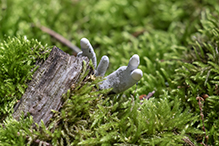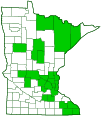Candlesnuff Fungus
(Xylaria hypoxylon)
Conservation • Description • Habitat • Ecology • Distribution • Taxonomy
|
|
||||||||||||||
Description |
Candlesnuff Fungus is a common and widespread, wood-rotting fungus. It occurs in Europe, in eastern and western North America, and in subtropical and tropical regions worldwide. It occurs in the United States and southern Canada east of the Great Plains and on the West Coast. It is found from spring through fall in a variety of habitats. It appears scattered, in groups, or clustered, on logs, fallen branches, dead stumps, and buried branches of hardwood trees. Candlesnuff Fungus gains its nutrients from dead wood (saprobic). Most wood-rotting fungi consume cellulose, hemicellulose, and lignin (white-rot fungi); cellulose, hemicellulose, and to some extent lignin (soft-rot fungi); or just cellulose and hemicellulose (brown-rot fungi). Candlesnuff Fungus and other fungi in the Xylariaceae family are secondary decomposers, targeting wood that has already decayed by the primary decomposers white-rot and brown-rot fungi. They consume only glucan and other minority ingredients that bind the wood together. Candlesnuff Fungus is extremely variable in shape and appearance. When it first appears, the fruiting body is erect, slender, ¾″ to 4″ (2 to 10 cm) long, and 1⁄16″ to ⅝″ (2 to 15 mm) thick. It may be either cylindrical with a pointed tip or club-like. As it matures, the tip develops branches or forks. The branches are often flattened, making the tip look like a moose’s antler. The lower portion of the fruiting body is sterile, black, and finely downy. The upper portion is powdery and gray to almost white due to a dense covering of asexual spores (conidia). Sometimes the entire fruiting body is covered with these conidia. The extreme tips are thinner, hairless, and whitish to yellowish. This is the asexually reproductive (anamorphic) stage. The fruiting body eventually turns entirely black. The upper outer surface becomes minutely roughened with tiny, pimple-like bumps (perithecia). This is the sexually reproductive (telemorphic) stage. The flesh is white and tough. It is not poisonous, but it is too small and much too tough to be edible. The asexual spore print is white, but under a microscope the spores are colorless. The sexual spore print is black, but under a microscope the spores are brown. |
Similar Species |
Habitat and Hosts |
Decayed wood of hardwood trees |
Ecology |
Season |
Spring through fall |
Distribution |
||
|
Sources Biodiversity occurrence data published by: Minnesota Biodiversity Atlas (accessed through the Minnesota Biodiversity Atlas Portal, bellatlas.umn.edu, 7/2/2025). |
|
| 7/2/2025 | ||
Occurrence |
||
|
||
Taxonomy |
|
Kingdom |
Fungi (Fungi) |
Subkingdom |
Dikarya |
Phylum |
Ascomycota (Sac Fungi) |
Subphylum |
Pezizomycotina (Sac Fungi and Lichens) |
Class |
Sordariomycetes |
Subclass |
Xylariomycetidae |
Order |
Xylariales |
Family |
Xylariaceae |
Genus |
Xylaria |
Xylaria hypoxylon is highly variable in shape and appearance. The Global Biodiversity Information Facility (GBIF) and iNaturalist.org both show Xylaria hypoxylon present in Europe, in eastern and western North America, and in subtropical and tropical regions worldwide. A recent molecular and morphological study (Fournier et al., 2011) “proved conclusively that X. hypoxylon occurs in the northwestern USA, but has apparently been confused with the similar X. vasconica in eastern North America.” According to Michael Kuo (MushroomExpert.com) “Evidence so far supports the presence of the true Xylaria hypoxylon in Europe and the West Coast of the United States, in temperate climates but not subtropical and tropical areas. Eastern North American collections may represent Xylaria vasconica (Fournier et al. 2010), a closely related but recently named species that does not usually develop "antlers," or Xylaria longiana.” |
|
Subordinate Taxa |
|
Several subspecies, varieties, and forms have been described. Index Fungorum and MycoBank both treat these as synonyms and recognize no subordinate taxa. |
|
Synonyms |
|
Clavaria hypoxylon Cordyceps hypoxylon Cordyceps hypoxylon ssp. cupressiformis Cordyceps hypoxylon ssp. pedata Cordylia hypoxylon Cordylia hypoxylon ssp. cupressiformis Cordylia hypoxylon ssp. pedata Hypoxylon cornutum var. ramosum Sphaeria adscendens Sphaeria cupressiformis Sphaeria hypoxylon Sphaeria hypoxylon var. cupressiformis Sphaeria hypoxylon var. pedata Sphaeria ramosa Xylaria adscendens Xylaria cornuta Xylaria cupressiformis Xylaria hypoxylon ssp. adscendens Xylaria hypoxylon var. bowmanii Xylaria hypoxylon var. cupressiformis Xylaria hypoxylon var. erythraea Xylaria hypoxylon var. mucronata Xylaria hypoxylon var. pedata Xylaria hypoxylon var. uviformis Xylaria subtrachelina Xylaria xypoxylon Xylosphaera adscendens Xylosphaera hypoxylon Xylosphaera hypoxylon ssp. adscendens |
|
Common Names |
|
Candlesnuff Fungus |
|
Glossary
Conidium
An asexual spore produced by some fungi. Plural: conidia.
Saprobic
A term often used for saprotrophic fungi. Referring to fungi that obtain their nutrients from decayed organic matter.
Glows in the Dark?
Candlesnuff Fungus is said to be bioluminescent. However, like most other bioluminescent fungi, the bioluminescence is very weak. Seeing it would require a long exposure photograph or night vision goggles.
Visitor Photos |
||
Share your photo of this fungus. |
||
This button not working for you? |
||
Greg Watson |
||
 |
 |
|
MinnesotaSeasons.com Photos |
||
|
||
|
||

Slideshows |
|

Visitor Videos |
||
Share your video of this fungus. |
||
This button not working for you? |
||
|
Other Videos |
||
Identifying Candlesnuff Fungus, Xylaria hypoxylon |
About
Jan 8, 2024 This common saprotroph is one of our key woodland recyclers. |

|
Created: 7/2/2025 Last Updated: © MinnesotaSeasons.com. All rights reserved. |


